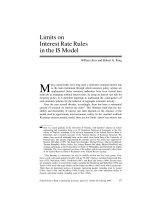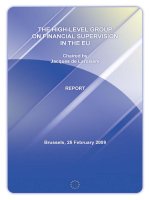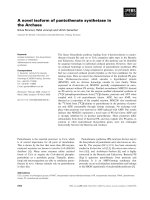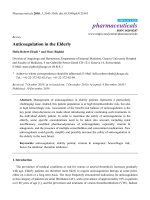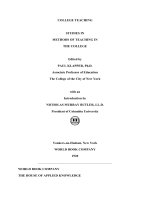Icarus in the Boardroom pot
Bạn đang xem bản rút gọn của tài liệu. Xem và tải ngay bản đầy đủ của tài liệu tại đây (1.06 MB, 261 trang )
Icarus in the Boardroom
David Skeel
Icarus in the Boardroom
The Fundamental Flaws
in Corporate America and
Where They Came From
1
2005
1
Oxford New York
Auckland Bangkok Buenos Aires Cape Town Chennai
Dar es Salaam Delhi Hong Kong Istanbul Karachi Kolkata
Kuala Lumpur Madrid Melbourne Mexico City Mumbai Nairobi
São Paulo Shanghai Taipei Tokyo Toronto
Copyright © 2005 by Oxford University Press, Inc.
Published by Oxford University Press, Inc.
198 Madison Avenue, New York, New York 10016
www.oup.com
Oxford is a registered trademark of Oxford University Press
All rights reserved. No part of this publication may be reproduced,
stored in a retrieval system, or transmitted, in any form or by any means,
electronic, mechanical, photocopying, recording, or otherwise,
without the prior permission of Oxford University Press.
Library of Congress Cataloging-in-Publication Data
Skeel, David A., 1961–
Icarus in the boardroom : the fundamental flaws in corporate America
and where they came from / by David Skeel.
p. cm.
ISBN-13 978-0-19-517471-7
ISBN 0-19-517471-2
1. Corporate governance—United States. 2. Directors of corporations—United States.
3. Industrial management—United States. I. Title.
HD2785.S437 2004
338.0973—dc22 2004009677
987654321
Printed in the United States of America
on acid-free paper
For Carter and Stephen
This page intentionally left blank
Acknowledgments
T
hanks go first to David Kairys and Dedi Felman. David, a
friend and colleague for well over a decade, first proposed
that I write the book in fall 2002, then spent months going back
and forth with me on the ideas and structure. Dedi, my editor,
also shaped both the initial structure and final version of the
book, reading and editing every paragraph of every chapter with
extraordinary care and insight. It would be hard to overstate
Dedi’s and David’s influence. They have been collaborators—
almost like co-authors—on every aspect of the book.
I was blessed to have several excellent research assistants while
I was writing the book. Seth Chertok spent a year plowing
through old hearings and other historical information, as well as
researching more recent developments. Michael Sherman pro-
vided equally able assistance in his final year of law school, before
heading off to New York law practice.
Several colleagues and friends read drafts of the entire manu-
script. I am especially grateful to Mitu Gulati and Mark West for
extensive comments and encouragement throughout the project.
Brian Cheffins provided numerous insightful suggestions, both
in writing and on a crowded train ride from London to Cam-
bridge. Reuven Avi-Yonah, Jeff Bauman, Sally Benner, Nell
Minow, and David Skeel Sr. also offered valuable comments at
key points in the writing process.
Thanks also to Bill Draper, Merle Slyhoff, and the staff at the
Biddle Law Library at the University of Pennsylvania Law School
who cheerfully (and quickly) tracked down even the most ob-
scure source materials. It is hard to imagine that there is a better
law library anywhere.
I am grateful to my dean, Mike Fitts, for his ongoing encour-
agement, to the University of Pennsylvania Law School for gen-
erous summer funding, and to Jessica Ryan and Tracy Baldwin
for the copyediting and design.
The germs of several of the arguments in the book date back
to a short piece Mark Noll and John Wilson invited me to write
for Books and Culture, and to an op-ed John Timpane commis-
sioned for the Philadelphia Inquirer. Thanks to each of them for
the invitations.
I am most grateful of all to my family. My parents are ever-
encouraging, even when work has interfered with the possibility
of visits. My in-laws, Erich and Kay Haegele, live nearby and are
always ready to lend a helping hand. To my wife, Sharon, I owe
deep gratitude of every kind. The Proverbs say that a virtuous
woman is much to be praised; Sharon is that and much more,
from scholar to mother and wife and friend. The book is dedi-
cated to our children Carter and Stephen. Watching them grow
up is one of the great joys of our lives. My prayer is that they will
look back on this time as an era when the fundamental flaws in
corporate America were addressed.
viii | Acknowledgments
Contents
Introduction 3
One Jay Cooke and the Birth of America’s
First Large-Scale Corporations 15
Tw o The Gilded Age and the Crisis of Competition 50
Three Icarus Meets the New Deal 75
Four “ I Want to Be Like Mike”: LBOs and
the New Corporate Governance 107
Five Enron, WorldCom, and the Transformation
of Icarus 143
Six “ The Most Sweeping Securities Law Reforms since
the New Deal” 175
Seven “ We Have Met the Corporation and It Is Us” 193
Notes 217
Index 235
This page intentionally left blank
Icarus in the Boardroom
This page intentionally left blank
Introduction
A
mericans have always loved risk-takers, the man or woman
with ambition and vision who goes for broke. “Boldness of
enterprise is the foremost cause of its rapid progress, its strength
and its greatness,” Tocqueville wrote as he surveyed the nation’s
business landscape well over a century ago. Although American
business and financial life reminded this French observer of “a
vast lottery,” he marveled at the extent to which Americans “en-
courage and do honor to boldness in commercial speculations.”
1
In Tocqueville’s era, adventurers set out for the western fron-
tiers to launch trading operations or speculate on land. Closer to
home, they invented the steamer, the cotton gin, and a thousand
lesser-known inventions. Jay Gould, who became the most fa-
mous of the post–Civil War railroad robber barons, got his start
by boarding a train to New York to peddle a mousetrap his
family had invented.
2
A century later, Hewlett-Packard was
started by two friends who hammered out their vision night after
|
night in a Silicon Valley garage, and a subsequent generation of
high-tech whizzes raced to create the next “killer app,” or what
business writer Michael Lewis labels the “New New Thing.”“The
U.S. has the world’s most diverse and efficient capital markets,”
Thomas Friedman wrote in , “which reward, and even cele-
brate, risk-taking.”
3
True risk-taking is a gamble. The entrepreneur literally takes a
chance. Unfortunately, even the most talented entrepreneur can
overstep his or her bounds, taking one risk too many and losing
it all. Indeed, the very qualities that make brilliant innovators
special—self-confidence, visionary insight, the ability to think
outside the box—may spur entrepreneurs to take misguided
risks in the belief that everything they touch will eventually turn
to gold.
Throughout this book, I characterize these qualities as
“Icaran,” based on a legendary risk-taker named Icarus whom
many of us remember from a high school reading list.
I
n ancient Greek lore, Icarus was the son of Daedalus, a famous
architect who constructed an elaborate labyrinth at the behest
of Minos, the King of Crete, to house a ferocious monster known
as the Minotaur. The labyrinth was so intricate and subtly con-
structed that even Daedalus and Icarus could not figure out how
to escape. After days of wandering into one dead end after an-
other, Daedalus “made a pair of wings,” as an Anglo Saxon poet
later put it, “contrived of wood and feathers and a cunning set of
springs.” As they prepared to test the wings they would use to es-
cape, Icarus’s father repeatedly warned him not to fly too close to
the sun. The feathers of his wings were attached to their wood
frame by wax, which would melt if he flew too high.
4
At first, Icarus heeded the warnings he had been given. But as
he became acclimated to the wings and reveled in his newfound
freedom, Icarus thought less and less about the risk, and more
| Icarus in the Boardroom
and more about the majesty of his powers. He continued to soar
upward, ever closer to the sun, until the wax softened, his feath-
ers gave way, and Icarus crashed down into the sea.
I
n a famous poem depicting the Icarus myth, W. B. Auden imag-
ines the hubristic youth splashing into the ocean within sight of
a farmer and a large ship. Neither pay much heed to Icarus’s
tragic fall. The farmer continues to work, “and the expensive
delicate ship that must have seen / Something amazing, a boy
falling out of the sky, / Had somewhere to get to and sailed
calmly on.”
5
Auden obviously is exaggerating for poetic effect, but the fail-
ure of an ordinary American entrepreneur is similar in some re-
spects. When a would-be innovator with a visionary idea puts
every dollar he or she has or can borrow into an Internet innova-
tion, but the dream collapses, it isn’t headline news. Even if the
entrepreneur loses everything, the failure may not ripple much
further than a few family and friends.
Put Icarus in the boardroom and everything changes. The
ability to tap huge amounts of capital in enterprises that adopt
the corporate form, together with the large number of people
whose livelihood depends in one way or another on the business,
means that the stakes are extraordinarily high if Icarus is run-
ning a major corporation. An Icaran executive who takes exces-
sive or fraudulent risks with a large corporation may jeopardize
the financial lives of thousands of employees, investors, and sup-
pliers of the business.
As American corporations expanded in the nineteenth cen-
tury, their size and complexity not only increased the stakes; it
also multiplied the opportunities for mischief. Once lawmakers
permitted a corporation to hold the stock of other corporations,
managers could tuck some of the assets of a business in one cor-
poration and other assets elsewhere. This organizational flexi-
Introduction |
bility often serves legitimate purposes, but it also can be used to
mislead investors about the financial health of the business and
just what it is up to. Both in the s and with Enron in our era,
investors continued to pump money into companies that were
headed for a fall, long after the company’s misguided risks would
have been obvious were it not for their intentionally and mystify-
ingly complex corporate structure. Only in retrospect did in-
vestors learn that the corporate house was full of false doors and
hidden rooms.
Although we rightly pride ourselves on the competitiveness of
the American markets, competition increases the odds of spec-
tacular corporate failures. In other countries—Germany, for in-
stance, and much of Asia—it is not unusual for one or a small
group of corporations to dominate their industry. Americans, by
contrast, have always rebelled against concentrated economic
power, in favor of industries with a multitude of competing
firms. “We entirely disapprove of the incorporation of compa-
nies,” a trade union representative complained in , “inas-
much as we believe their tendency is to eventuate in and produce
monopolies, thereby crippling the energies of individual enter-
prise, and invading the rights of smaller capitalists.” In this kind
of marketplace, the success of a business innovator is sure to
attract competitors—the more spectacular the success, the
fiercer the efforts to get a piece of the pie. Although some inno-
vations can be patented, many, such as financial innovations or
novel business strategies, usually cannot. As competitors enter
their market, innovators often see their lavish profits begin to
slip away. All too often, the innovators respond by taking increas-
ingly misguided and even illegal risks as they attempt to replicate
their early success.
6
These three factors—excessive and sometimes fraudulent
risks, competition, and the increasing size and complexity of the
corporation—have been at the heart of a series of devastating
crises that have punctuated American corporate and financial
| Icarus in the Boardroom
life for the past hundred and fifty years. The first came with the
collapse of financial genius Jay Cooke, who pioneered a new
strategy for selling government debt during the Civil War; the
Great Depression saw the crash of utilities magnate Samuel
Insull; and the new century brought still another wave of corpo-
rate scandals. Throughout the book, I will refer to crashes that fit
this pattern as Icarus Effect failures.
Underneath and in between the scandals is an ongoing cat-
and-mouse game between regulators and the leaders of Ameri-
ca’s largest corporations. Ever since the first large-scale corpora-
tions emerged in the nineteenth century, the task of regulators
has been to rein in the three factors that can lead to Icarus Effect
failures, as these tendencies are manifested in each succeeding
era. Congress and state lawmakers sometimes target the first,
risk-taking, directly, as when they impose penalties for misbe-
havior, but they also empower market “watchers” such as ac-
countants or securities analysts to scrutinize the decision making
of corporate executives. The second factor, competition, is regu-
lated either by increasing the amount of governmental interven-
tion, as with railroad-rate regulation in the nineteenth century
and utilities regulation in the twentieth; or by decreasing it, as
with the more relaxed antitrust scrutiny and extensive deregula-
tion of recent years. With corporate size and scope, the final
factor, lawmakers attempted at first to impose direct size restric-
tions, then later focused on limiting the complexity of inter-
related corporate structures that were made possible once corpo-
rations were permitted to own the stock of other corporations.
Although strict regulation can rein in the Icaran tendencies in
American corporate and financial life, it also undermines flexibil-
ity and innovation. In every generation, American corporate lead-
ers have responded by simply evading existing regulation or by
lobbying for changes that give business more flexibility to expand
or take advantage of technological innovations. In the nineteenth
century, growing businesses chafed at the strict rules that limited
Introduction |
the amount of capital they could raise. Larger companies, they ar-
gued, are more efficient and produce goods more cheaply than
smaller ones. In our era, corporations use complex financing
techniques to circumvent regulatory restrictions of various kinds.
An insurance company that wishes to insure a larger amount of
risk than regulators or its own shareholders will allow can set up a
special new entity to assume the risk. This is one illustration of the
financial rocket science known as structured finance.
It is a simple fact of interest-group politics that corporate
executives wield extraordinary influence over the political pro-
cess both at the state and federal levels under ordinary circum-
stances. Corporate managers are intensely interested in the regu-
latory landscape, and they are backed by the huge coffers of the
corporation itself. As a result, they usually get what they want.
Ordinary Americans, by contrast, are much less likely to focus on
the issues at stake and do not have nearly the same access to po-
litical decision makers. Few Americans entertained President
Grant in their homes, as Jay Cooke did in the s; nor have
many of us received endearing notes from President Bush like
the birthday and Christmas cards he once penned to “Kenny
Boy,” Enron’s Ken Lay.
The efforts by American business to sidestep regulatory over-
sight can quickly spiral out of control, setting the stage for a
devastating breakdown in corporate and financial oversight. The
most dramatic collapses have occurred in times of market eu-
phoria, often after a period of technological and financial inno-
vation. Unlike in Auden’s poem, the result of a true Icarus Effect
scandal is far from an “unimportant failure.” Thousands of jobs
are lost and thousands of lives ruined when an Insull or Enron
implodes. And for every Insull or Enron—for every Icarus Effect
scandal writ large—there are other companies that follow the
same Icarus Effect script. The headline scandals invariably reflect
a broader crisis in American business life, a pervasive failure to
keep the three Icaran tendencies in check.
| Icarus in the Boardroom
As devastating as these failures are, they also have a silver lin-
ing. When the empire created by an erstwhile financial genius
comes crashing down in a wave of scandal, ordinary Americans
awaken from their slumber. Their outrage has often galvanized
public opinion in favor of sweeping corporate reforms that
would be politically inconceivable—political nonstarters—in a
more placid corporate and financial environment. Our most im-
portant corporate regulation has always been enacted in the
wake of stunning Icarus Effect collapses.
7
The importance of scandals doesn’t mean that lawmakers dis-
appear after the crisis passes, of course. They continue to tinker
with corporate and financial regulation, particularly at the state
level. But these interim changes usually have corporate America’s
fingerprints all over them. It is only when scandals handcuff
America’s corporate leaders that lawmakers take direct aim at the
Icaran tendencies in America corporate life.
8
Corporate scandals are not unique to America, of course. Just
about every country with large corporations has had its share of
corporate scandals. But the scandals of other countries have
tended to take different forms. In Japan, for instance, many of
the most notorious scandals have involved rogue traders and
midlevel insiders. In and , executives at fourteen major
companies (including Japan Air, Toshiba, and Hitachi) were ar-
rested for paying thugs—sokaiya—to squelch discussion at their
annual shareholders’ meetings. In each case, the payments were
made by a midlevel employee who did not derive any personal
profit from the payments. In America, by contrast, spectacular
failures usually start at the top and can be traced back to an
Icaran executive who kept gambling even after his fortune or
skill ran out, using the size and complexity of the corporation to
disguise his flight. America’s widely held companies and vibrant
stock markets seem to be a particularly congenial environment
for, and at times even to invite, Icaran excesses.
9
To understand the three Icaran tendencies—risk-taking, com-
Introduction |
petition, and corporate size and complexity—as well as the his-
torical tug-of-war between regulators and corporate leaders, we
need to start with the origins of the American corporation. In
chapter , I describe the dramatic surge in incorporations in the
nineteenth century. Unlike partnerships, corporations were diffi-
cult to dissolve, which protected businesses against the possi-
bility that death or a falling out would force a dissolution. By the
second half of the century, corporations also provided limited
liability. Limited liability meant that shareholders generally
could not be held responsible for the corporation’s debts, which
made corporate stock a very attractive investment. The first busi-
nesses to take advantage of this by tapping large amounts of
capital from investors were the railroads, the nation’s first large-
scale corporations. The rise of the railroads also brought the first
true Icarus Effect failure, the devastating collapse of Philadelphia
banker Jay Cooke and his vast Northern Pacific Railroad project.
Cooke’s failure, and the excesses of the railroad robber barons,
not only led to specific legislative reforms, but also propelled the
coalition of farmers and small business owners that became
known as American Populism into the national spotlight.
Chapter chronicles the rise of the great corporate trusts
of the Gilded Age, as John D. Rockefeller and other business
titans outmaneuvered the efforts of state regulators to limit the
size and scope of the railroads and other corporations. If the
corporate-trust movement had continued, it might, in rather
perverse fashion, have eliminated the Icaran tendencies in
America’s large-scale corporations. Great trusts such as Rocke-
feller’s Standard Oil and Andrew Carnegie’s steel empire cut off
competition in their industries. The absence of competition re-
moves the pressure to take risks and thus decreases the threat of
Icarus Effect failures, since the monopoly business can earn large
profits without any serious encroachment from competitors. The
prospect of concentrated economic power has always drawn
resistance in this country, however. Teddy Roosevelt’s trust-
| Icarus in the Boardroom
busting campaign tapped into the resistance and signaled that
there were limits to the amount of concentration that would be
tolerated. Although Roosevelt abandoned the effort to directly
restrict corporate size, his trust-busting campaign reflected a re-
newed commitment to industry competition.
The decades leading up to the stock-market crash saw
the most important shift in corporate structure in American
business history. Whereas the shareholders of even the largest
corporations had actively managed the company and served as
its directors in the nineteenth century, the emergence of corpo-
rate giants at the end of the century led to a separation of owner-
ship and control. Shareholding became widely diffused, and
shareholders played little role in the management of many of the
nation’s largest corporations. In some industries, J. P. Morgan
& Co. and other investment banks continued to seek to combine
the principal competitors in order to “rationalize” (their euphe-
mism for forging a monopoly) competition. In the utilities
industry, corporate leaders like Samuel Insull manipulated the
corporate form, creating complex structures of parent and sub-
sidiary corporations that enabled them both to maintain control
with a small ownership stake and to raise money from investors
who didn’t understand the distinctions among the interrelated
corporations.
Although Insull is largely forgotten today, the spectacular
Icarus Effect collapse of his Chicago-based utilities empire per-
sonalized the need for sweeping reform. After campaigning in
against “the Ishmael or Insull whose hand is against every
man’s,” Franklin D. Roosevelt and the New Dealers restructured
American business and financial regulation with a series of
reforms that targeted each of the Icarus Effect factors. As
described in chapter , the securities reforms of and
required extensive disclosure, added antifraud provisions, and
reinforced the role of accountants and securities analysts as
watchers, all of which made it more difficult for Icaran executives
Introduction |
to take excessive risks. New Deal banking reforms ended the
monopoly of Morgan and the Money Trust over American fi-
nance; this and aggressive antitrust enforcement reinvigorated
competition in some industries, while others settled into a com-
petitive equilibrium. Although the New Dealers’ principal cura-
tive for abuses of corporate size and complexity was disclosure,
they intervened more directly in the utilities industry, forcing a
complete restructuring of the industry under the so-called death
penalty provision included in the Public Utilities Holding Com-
pany Act of .
The New Deal reforms brought both an increasing federaliza-
tion of corporate regulation and a shift from the rigid, per se
rules that lawmakers had used in the nineteenth century to a
more nuanced approach to regulation. Like corporate America,
corporate and financial regulation had also come of age.
For the next several decades, the Icaran tendencies in Ameri-
can corporate life seemed to go into remission. As described in
chapter , this all changed in the s and s, thanks to a
takeover boom fueled by the junk-bond operation pioneered by
Michael Milken and Drexel Burnham Lambert, together with
deregulation and decreased antitrust scrutiny. These changes
reinvigorated the Icaran tendencies in American corporate life.
Managerial risk-taking returned after an era when corporate
leaders had functioned more like bureaucrats than entrepre-
neurs, and competition was reintroduced into industries like
telecom and utilities. The s also saw the first hints of the
financial innovations which would create new opportunities
for manipulation of the corporate structure in the decade that
followed.
The final three chapters shift from history to the present.
Milken’s indictment and incarceration brought Drexel
crashing down in Icarus-like fashion. But Milken’s fall differed
from previous Icarus Effect failures in important respects and
served principally as foreshadowing of the scandals that later fol-
| Icarus in the Boardroom
lowed. Chapter chronicles the rise of charismatic CEOs like
Enron’s Ken Lay and Bernie Ebbers of WorldCom, the role of
continued deregulation, and the use of innovations such as
structured finance—the “sale” of assets to separate but often re-
lated business entities—to evade regulation and mislead in-
vestors. Chapter focuses on the corporate-responsibility legis-
lation that was enacted in response to the outrage provoked
by the collapse of Enron and WorldCom and by the crisis of con-
fidence in corporate America. The new legislation attempted
to remedy the conflicts of interest that discouraged directors,
auditors, and securities analysts from reining in Icaran risk-
taking and manipulation. But it did little to alter the underlying
incentives for corporate leaders to take excessive risks and left the
other two Icarus factors—the competitive structure of industry
and the misuse of corporate size and complexity—largely un-
touched. Chapter explains why the powder keg is still very
much in place. Corporate culture continues to reward managers
who are willing to take risks and don’t second guess the genius of
the decisions they make. The competitive structure of important
industries is still in turmoil. And regulators have not yet caught
up to innovations that companies use to move assets and liabili-
ties around a web of corporate entities.
For much of American business history, the risks posed by the
Icaran tendencies in American business and financial life were,
for most ordinary Americans, somewhere off in the distance. Al-
though Jay Cooke’s principal innovation was to market govern-
ment debt and then railroad bonds more broadly than ever
before, only a few Americans had extra savings to invest in stock
or bonds. Even for wealthy investors, the investment of choice
was real estate, not the stock market. By the end the nineteenth
century, increasing numbers of upper- and upper-middle-class
Americans ventured into the stock markets, and this trend inten-
sified in the roaring twenties, when millions of ordinary Ameri-
cans bought stock or bonds. But for much of the twentieth cen-
Introduction |
tury, the stock market was still viewed primarily as the play-
ground of the rich.
Not any more. For the first time, more than half of all Ameri-
cans now own stock, either directly or through mutual funds.
This in itself is a stunning development. Equally remarkable is
the fact that much of this stake is retirement money and other
savings, not money that Americans have intentionally put at risk.
The most obvious victims of the Enron and WorldCom col-
lapses, after all, were the thousands of men and women whose
retirement portfolios were wiped out. As I argue in the final
chapter, these developments have enormous implications for
the next generation of corporate reform. Any effort to correct the
Icaran tendencies in corporate America must account for the
stake that millions of Americans now have in the market.
The long history of Icarus Effect scandals, and of the ever-
evolving skirmish between regulators and corporate leaders, is
no longer simply a fascinating and at times heart-wrenching his-
torical tale. It is a tale that involves more of us than ever before.
The story you are about to read is your story too.
| Icarus in the Boardroom

